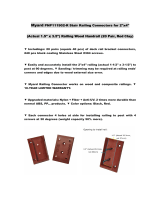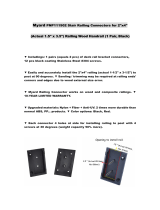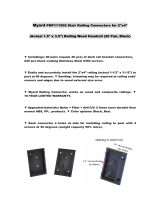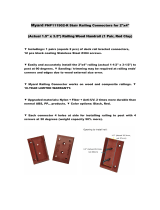Page is loading ...

ALUMINUM BALUSTER
INSTALLATION INSTRUCTIONS
Step 1: Measure railing opening from post to post to determine
the length of each baluster rail section (fig. 1).
Step 2: Cut top and bottom rails (2x4’s) to length and clamp
together. Mark top and bottom rails 4-1/2" on-center, starting
from the center of the rail (fig. 2).
Step 3: Using a drill driver, screw on baluster connectors on
each mark using the screws provided (fig. 3). Apply silicone
caulk on each connector to prevent balusters from turning or
rattling after installation is complete. The caulk should be on the
outside of the connector, where the baluster will make contact
with the connector’s outer edge.
Note: Specific types of treated lumber are known to corrode
aluminum. The baluster connectors provide a barrier between
the aluminum balusters and treated lumber to ensure long term
performance.
Step 4: Place the bottom rail between the rail posts, supported
by a 3" block (2x4 scrap material works best) (fig. 4). Secure
rail to posts using rail connectors and slide balusters over the
bottom connectors (fig. 5). Carefully place top rail over the
balusters, making sure each baluster is seated properly on each
connector.
Step 5: Inspect finished railing for proper baluster spacing and
secure top rail. Add a cap rail for a finished look (fig. 6).
Step 6: For rail sections longer than 4', support blocks are
recommended. These can be made from leftover 2x4 rail
material. Properly position the support block and toe-nail it
to the bottom rail and deck board (fig. 7).
In-Line Railing
©2015 Universal Forest Products, Inc. All rights reserved.
US Route 202, Greene, ME 04236 8397_7/15
www.ufpi.com
Kit contents
• 15 - Aluminum balusters
(2.5 balusters required
per linear foot of railing)
Preparation
Items you will need
• Rail connectors
(optional, sold separately)
• Drill driver
• Tape measure
• Clamps
• Safety glasses
• Carpenter’s pencil
• White rubber mallet
• Support blocks (can be
cut from scrap rail material)
Prior to construction, check with your local regulatory agency
for special code requirements in your area. Common railing
height is 36". Structural support should come from either the
continuation of deck support posts that extend up through the
deck floor or from railing posts that are bolted to the inside of
the rim or outer joist. 6' on-center post spacing is recommended.
Never span more than 8' on-center between railing posts.
fig. 1 fig. 2
fig. 3
fig. 4
fig. 5 fig. 6
fig. 7
• 30 - Horizontal baluster
connectors
• 10 - Stair baluster connectors

ALUMINUM BALUSTER INSTALLATION INSTRUCTIONS
Step 1: Stair rails and balusters can present an installation
challenge. Stair baluster connectors create a snug and accurate
baluster fit for stair angles ranging from 30 to 35 degrees (fig.1). Cut
top and bottom stair rails at the proper angle. Lay top and bottom
2x4 rails alongside the posts and mark.
Step 2: Clamp the top and bottom rails together with the top
2x4 rail inverted. Position rails as shown and mark 5-1/2"
on-center, working from the center out to the ends of the rails
(fig 2).
Step 3: Properly position the connectors on the rails. The top
and bottom connectors will be facing opposite directions (fig. 3).
Screw the connectors in place. To properly set connectors, begin
screwing vertically until the screw bites into the wood (fig. 4).
Reposition screw to the proper angle and tighten. Do not over-
tighten, which can move the connector off center.
Step 4: Make sure connectors are properly aligned, apply silicone
caulk to each connector and assemble the top and bottom rails
with the balusters (fig. 5). Then attach full rail section between the
stair rail posts (fig. 6).
©2015 Universal Forest Products, Inc. All rights reserved.
US Route 202, Greene, ME 04236 8397_7/15
www.ufpi.com
Stair Railing
THE DIAGRAMS AND INSTRUCTIONS IN THIS BROCHURE ARE FOR ILLUSTRATION PURPOSES ONLY AND ARE NOT MEANT TO REPLACE A LICENSED PROFESSIONAL. ANY CONSTRUCTION OR
USE OF THE PRODUCT MUST BE IN ACCORDANCE WITH ALL LOCAL ZONING AND/OR BUILDING CODES. THE CONSUMER ASSUMES ALL RISKS AND LIABILITY ASSOCIATED WITH THE
CONSTRUCTION OR USE OF THIS PRODUCT. THE CONSUMER OR CONTRACTOR SHOULD TAKE ALL NECESSARY STEPS TO ENSURE THE SAFETY OF EVERYONE INVOLVED IN THE PROJECT,
INCLUDING, BUT NOT LIMITED TO, WEARING THE APPROPRIATE SAFETY EQUIPMENT. UNIVERSAL FOREST PRODUCTS, INC., MAKES NO WARRANTY, EITHER EXPRESS OR IMPLIED,
AND SHALL NOT BE LIABLE FOR ANY DAMAGES, INCLUDING CONSEQUENTIAL DAMAGES.
fig. 1
fig. 2 fig. 3
fig. 4 fig. 5
fig. 6
/




